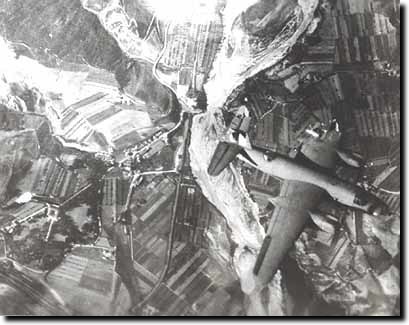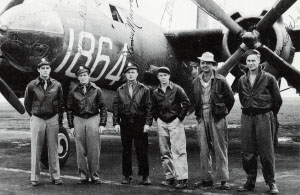![]()
Marauder
- A Pilot's Story
"No Visible Means of Support"
by
Charles O'Mahony, 441st Bomb Squadron
|
Maurader
- |
The airfield at Decimomannu on the island of Sardinia was like not other I had ever seen--oiled-down, parallel strips just over 8,000 feet long and wide enough for our Marauders to take off and land six abreast. My first view of “Decimo” was on the Fourth of July, 1944, and it came after a 600-mile flight across the Mediterranean from Camp Canastel replacement depot in Oran. Our crew was being ferried in by Lt. Bob Borden, a veteran combat pilot, in a battle-scarred B-26. We streaked across the airfield and over the squadron area t treetop level, the needle on the airspeed indicator at the 300mph mark.
“Gotta let the motor pool guys know we need transportation,” Borden shouted. He couldn’t have gotten their attention any better unless he strafed them, I thought. After we landed, a truck arrived promptly to pick us up, and our new squadron commander, Capt. “Snuffy” Smith, came to great us. After a casual salute, the captain advised us the mess hall would be serving supper at 1700 hours. “Sir,” I asked, “what’s the proper uniform for chow?” Puzzled at first, Capt. Smith finally said, “I guess if the guy sittin’ next to you doesn’t throw up, you’re in uniform.” I knew I was going to like it here.
|
|
Our squadron area billeting had a two-class system, one for veterans with a lot of missions and one for us “short-timers.” The veterans lived in “casas” pastel-colored homes they had built with the help of local labor. Some casas even had showers -- drums or fighter fuel tanks mounted on the roof, solar heated. Short-timers lived in pyramidal tents, six to a tent. Shaving and bathing were done from a helmet, outdoors. Once we had settled into our tent, Robbie, my copilot, and I spent much of our time watching the mission formation takeoffs, thoroughly intimidated. Our six-man crew was now part of the 441st squadron in the 320th Bomb Group, and the 319th Bomb Group was on the other side of the airfield. There were four squadrons in each group, each squadron with a complement of 24 Marauders. The 319th called their planes “The Big Ass Birds.” On missions, the 320th squadrons took off three at a time every 30 seconds, while the 319th takeoffs were six abreast every minute. Time saved in “joining up” served to extend our range. In spite of the oiled runway, dust billowed as soon as the first flight took off, and it was an awesome sight to watch succeeding flights come roaring out of those swirling brown clouds.
My first combat mission off Decimo came on 10 July. The night before, I had checked the mission roster, and my name wasn’t on it. I went inside the Operations tent to talk to Lt. Trunk. "Sir, a couple of my tent mates are scheduled for their third mission, and I haven't flown "numero uno yet." We walked outside and Trunk studied the crew names on a single typed page - - a nine ship formation that was the next day's mission.
“Can’t split the Wigs,” he said. “Say again?” “Oh, we got Murray Wiginton and Bill Wigginton,” Trunk said, pointing his pencil to a crew in the third flight on aircraft Zero Six. “No relation, but they came over on the same crew.” As a brand-new copilot, I could only be assigned to a position in the nine-ship squadron where I could keep the plane in formation if anything happened to my pilot. I couldn’t be assigned to the lead plane, or the backup ship on his right wing. Nor could I fly either of the two Marauders leading three-ship flights. “I’ll put you up here with Hubbard on One Six,” Trunk said, erasing the copilot’s name and penciling in mine. One Six was the big yellow battle number on the tail, and we were left wing on the squadron lead.
The next morning our Group Cmdr., Col. Fletcher, briefed us. “The 441st will be hitting this railroad bridge south of Marzabotta, Italy. The 443rd squadron will be hitting this bridge, here, north of the town. You’ll be carrying four 1,000-pound demolition bombs. You can expect light to moderate flak; no fighters.” After briefing we were issued a parachute, flak helmet and flak vest, a Mae West and $40 in Italian lire. We also got a packet containing a map of the target area (printed on silk), an escape kit with matches, Halazone tablets to purify water, a chocolate bar, a three-inch hacksaw blade and a compass no bigger than a dime. Toting some 50 pounds of equipment, we clambered aboard a truck that took us to our plane, where I did my best to become invisible. Lt. Hubbard was flying his 61st mission, and I didn’t want to confirm his suspicions that his copilot today was a “virgin.” We all kinda milled around and smoked, and then five minutes before engine startup, as if on cue, everybody walked to the tail of the plane and took a leak; it seemed like a good idea, with a four-hour mission ahead.
Ours was the first flight, and after the backup ship and squadron lead had taxied by, we followed in trail. We lined up on Capt. Robins’ left wing, half a ship-length behind, and when Robins waggled his ailerons and glanced back at us, Hubbard added power and nodded to signal he was ready. From the tower came “Wise guy leader, cleared for takeoff,” and halfway through the transmission Hubbard was off the brakes and we were rolling. I wanted to watch the formation takeoff, but my job was to monitor our plane’s engines. I put my right foot on the instrument panel to stop the vibrating. OK, 2,7OOrpm, manifold pressure too high, but that’s SOP here; oil pressure OK; everything in the green. Hubbard was tucked in close, eye glued on the lead ship. We broke ground, Hubbard gave me thumb up, and I raised the gear handle. Moments later, he eased back on the power and gave me four fingers: bring the props back to 2,4OOrpm for climb.
We climbed out on course in a loose formation to conserve fuel, north across Sardinia, along the east coast of Corsica, and by the time we made landfall at La Spezia we were at 12,000 feet. Hubbard signaled for me to take the controls, and he was breathing hard by the time he had struggled into his flak vest and snugged on helmet. The B-26 didn’t carry oxygen, and at this altitude, even the slightest effort left us panting. The lead ship made small course corrections as the navigator threaded us between antiaircraft batteries. As we droned on, tension mounted and then abruptly, we followed the lead ship in a steep bank to the right. When the flight rolled level, our bombardier said, “We’re at the IP; bomb-bay doors coming open.” There was a loud rush of air and a chill swept through the cockpit, but Hubbard’s forehead glistened with sweat. He was working hard, making big corrections with the throttles. The props were surging, never in synch, doing what it takes to stay close. We were really in tight on the lead ship now, slightly lower. Below, and to the left, puffs of black smoke appeared in clusters of four. More black bursts level with us now “There’s some ...” and I pointed, “and there’s some over there.”
“I can see it,” Hubbard shouted. He left off, “you dumb bastard,” but I got the message. We were flying straight as a string on the bomb run; our only evasive action was to lose altitude in irregular steps until we reached the 11,200-feet release altitude. In my headset, a panicked voice shouted, “The Wigs got hit! The Wigs got it!” We could hear the “WHOOMPF” of the flak now, and shrapnel rained over our plane. Hubbard never took his eyes off the lead ship.
 |
|
|
One of the better known WW II photos shows B-26 Zero Six of the 441st squadron flown by pilots Wigington & Wiggington just before it goes out of control after suffering a direct hit during the 10 July 1944 mission to Marzabotta, Italy, There were no survivors. The credit for this unusual photo is lost to history. |
“Bombs away!”
The bombs ticked out and we rolled into a steep turn, down and away, leaving
the flak behind. On the radio, some one said Zero Six had taken a direct hit “Took
the left wing off… no parachutes.” Hubbard motioned for me to take the controls,
then he slumped back in his seat and wiped the sweat from his forehead. “Hell,”
I thought, “it wasn't all that bad.” I was too green to realize that this was
my first time under fire—Hubbard’s 61st. (Continued)

Copyright(c) 2003 320th History Preservation. All rights reserved.



















